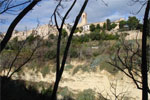Bosco del Cugnolo: from Torre di Palme back in time to the Pleocene | Itinerario

Difference in elevation: 60 meters
Time: 1 hour to 1.15 hours
Difficulty: Easy
The Bosco del Cugnolo, which is one of the very few intact stretches of the habitat known as Mediterranean macchia in all of the Adriatic region, can be traversed with a short, easy hike of about 2 kilometers. This wooded area, surrounded by cultivated fields, extends for about 9 hectares and takes its name from the countryside in which it is located, bordered by Fosso Cupo and Fosso Molinetto. Although the evergreen forest (or “macchia primaria”) has undergone a reduction in size and environmental degradation, the integrity of the area allows it to be classified as a “relict” and included under the Region’s designation of Protected Flora Areas.
The habitat is characterized by a hot temperate climate in which there is scarce precipitation concentrated in the winter months, alternating with very dry summers. Adaptation to this situation causes plant leaves to be small, but tough and thick, in order to retain water from transpiration. Because of this, the leaves of plants such as juniper and pine have evolved into needles. The vegetation pattern forms coppices, composed mainly of evergreen oaks, among which can be found some centenary examples. There are also unusual varieties of vines and climbing plants that at several points make the forest intricate and impenetrable.
The Bosco del Cugnolo is situated in a fossilized down dating to the Pleocene period, with an altitude ranging from 60 to 110 meters. Geologically, it is composed of marine sediments, especially various types of sand, which in many places takes the form of gravel and pebbles, forming a shelf about 450 meters long, which runs parallel to the sea at a distance of approximately 400 meters. The terrain is very unstable and, in the areas where vegetation is scarce, subject to frequent landslides. This also results in soil not well suited for agricultural use, which has definitely contributed to the conservation of the forest. The origin of the zone dates to the Quaternary period (between 1.5 and 1.8 million years ago). Intense tectonic movements, followed by strong climactic variations, have molded it into its current form.
At the halfway mark of the hike, it is possible to visit the Grotta degli Amanti (Cave of the Lovers), named after the real-life story of Antonio and his fiancée Laurina, which took place returning in 1911 during the colonial wars for the conquest of Libya . Returning home for a brief leave from his military post, Antonio fell in love with Laurina and decided never to part from her. Thus, he became a deserter. The couple found refuge in the cave, surviving for days on bread and sardines brought to them by local fishermen. After more than a week, the lovers felt overcome by remorse and, even more, the feeling of being at bay. Rather than separate, however, they decided to die by jumping 70 meters from the overhanging cliff of the Fosso di San Filippo, tied together with Laurina’s shawl. It was the grea tgrandfather who found the woman dead and Antonio with serious back injuries, which allowed him to live only a few days. Guarded by soldiers, he wondered about the reason for so much attention, given that if he ever managed to heal, he would be executed anyway.
Proceeding with the excursion, we soon arrive at the sixteenth-century Villa degli Aranci, a property belonging first to the Adami counts and then to the Azzolinos. The two noble families used the villa mainly as a summer residence where they could offer hospitality to prominent individuals. The trilevel construction has façades embellished with marcapiani and tympanums enhancing the second story. Although the villa is located in an elevated position, the natural conformation of the area protects it from northern and western winds. Throughout the centuries, this has permitted the cultivation of citrus, giving rise to the name Villa degli Aranci. To the north rises a small church erected near the cliff; a stone tablet posted on the façade of the chapel records the date as1648.
Beginning the tour of the town of Torre di Palme, one can gaze down from the stupendous terrace which overlooks the Piceno coast, taking in the view of the section called Agro Palmense extending as far as Monte Conero. Other enjoyable features of the town include its narrow streets decorated with flowers and its three churches. The church of Sant’Agostino contains a valuable polyptich by Crivelli and a painting by Pagani.





